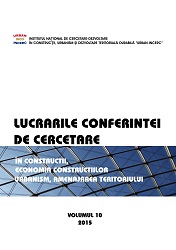Sisteme pasive – de la vernacular la contemporan
Passive systems - from vernacular to contemporary
Author(s): Alexandra Păcescu
Subject(s): Architecture
Published by: INCD URBAN-INCERC
Keywords: passive design (systems); vernacular; regionalism
Summary/Abstract: At present sustainable development is a more or less abstract term, an umbrella metaphor to describe different themes and variations. Contemporary architecture has shown two divergent trends. Firstly, a poetic, nostalgic return towards the traditional, the vernacular and the basic principles of dwelling. Secondly, an increase in technological display, in all its forms. Adobe and recyclable materials coexist with installation – like buildings that make use of all the new technical devices, under strict computer-assisted control. In between, a vast array of intermediary solutions could be the answer to the architecturallychallenging, energy-efficient building. The traditional city and the vernacular are the quintessential link between architecture and climate. They stand for energy efficiency and are associated with passive strategies of design, since they are the most basic and effective response to climate conditions and have withstood the test of time. These principles have been transferred to contemporary architecture and basic archetypes have been consistently interpreted to gain different meanings, some of them still making use of these passive strategies and adding new ones, both in terms of models for sustainable urban forms and individual buildings. As opposed to passive strategies, research in the field of active strategies, using non – renewable energy, have developed ways to counterbalance the limitations of passive design. These limitations, although acknowledged, should only be compensated when no other means exist. Otherwise, the risk is to rely on an active, more energy consuming way of building when more sustainable planning decisions could be made at the early stages of design, thus preventing unnecessary costs and depletion of resources.
- Page Range: 9-19
- Page Count: 11
- Publication Year: 2015
- Language: Romanian
- Content File-PDF

